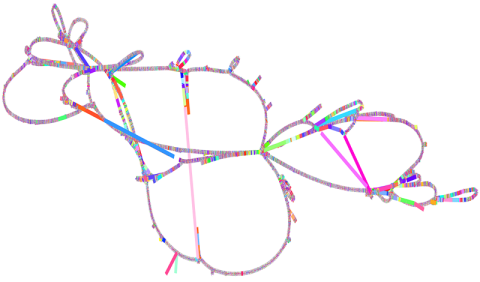A pangenome is an integrated collection of the genomes of multiple individuals from a specific species.

Until recently, genomics research used a single ‘reference’ genome to provide a baseline, rather than a collection of genomes. This means analysis and findings are always influenced by the reference genome. No single genome can represent the genetic diversity of an entire species, and rarer, but important diversity is easily missed.
Now that sequencing genomes is much less expensive, it is possible to sequence many genomes for a species. Sometimes an entire species can be sequenced, as is the case for kākāpō. However, combining genomes is not straightforward.
What we are doing
Genomics Aotearoa’s Genome Graphs project team is testing new techniques to better understand infectious diseases, as were used in the recent seminal paper on the first human pangenome.
Pangenome graphs are data structures used to represent and compare the genetic variation within a species or a population, providing a comprehensive view of their genetic diversity.
The aim of the Genomics Aotearoa Genome Graphs project is to make this new analysis process accessible to people across Aotearoa in many different sectors. The initial focus is on research in human health and primary industries, but it has broad applicability.
The project team works with the international group who created the Pangenome Graph Builder (PGGB), which is led by Erik Garrison at the University of Tennessee Health Science Center. The PGGB toolset is highly scalable, applicable to all species, and is highly regarded amongst current techniques for constructing pangenomes.
Project researchers Zoe Yang and Joep de Ligt tested PGGB in the analysis of pathogen genomes, specifically to analyse Neisseria meningitidis disease in Aotearoa.
A resulting manuscript was published with Frontiers in Genetics, with one of the reviewers commenting that the paper addresses both an urgent and an intriguing issue. “Obviously, pangenome graphs have great advantages over linear reference genomes when working with diverse pathogenic species. However, this seems to be the first study of that kind.”
The impact
Ultimately, this innovative approach paves the way for enhanced comparative genomics and a deeper comprehension of genetic variations in (infectious) diseases, thereby enhancing our understanding pathogen evolution and spread.”
The next year promises to be an exciting one as the team continues to push the boundaries of graph-genome methodologies, fostering collaborations, and hosting training workshops to contribute to capability in research institutions across the motu.
Read more about Genome Graphs here